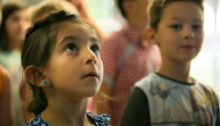 With their new film Miss Kiet’s Children, filmmaking couple Petra Lataster-Czisch and Peter Lataster have achieved something truly extraordinary. Over the course of two mesmerising hours, they’ve found a way to have viewers abandon their mundane adult perspectives, transporting them back to a time in which stolen crayons and memorising times-tables were great emotional challenges. Miss Kiet’s Children, which will soon premiere in Australia at the Melbourne Documentary Film Festival, is a triumph of documentary filmmaking.
With their new film Miss Kiet’s Children, filmmaking couple Petra Lataster-Czisch and Peter Lataster have achieved something truly extraordinary. Over the course of two mesmerising hours, they’ve found a way to have viewers abandon their mundane adult perspectives, transporting them back to a time in which stolen crayons and memorising times-tables were great emotional challenges. Miss Kiet’s Children, which will soon premiere in Australia at the Melbourne Documentary Film Festival, is a triumph of documentary filmmaking.
The film’s principal purpose is in documenting the trials and tribulations of a group of young immigrant children who find themselves in the difficult position of integrating into a new country and a new school. Of varying ages, all of these children are lucky enough to end up in the class of Miss Kiet, an incredibly patient, caring and diligent teacher – the kind we all had, or wish we had. Most of these children are Syrian refugees with a very limited understanding of Dutch, adding to the challenge of communicating. Thankfully, Miss Kiet has a distinct skill for identifying the motivations of children, and how to provide them with the support (and occasional discipline) that they need to grow and develop.
There are four children on which the Lataster’s focus most prominently. The first to enter our lives is Haya, an adorably domineering girl who’s always the first to correct the mistakes of her fellow classmates. She is soon followed by Leanne who, being a couple of years younger than Haya, soon becomes the partially-unwanted subject of Haya’s maternal affections. Some of the most poignant scenes come out of the dynamic between these two, as Haya’s impulse to look after Leanne results in her becoming increasingly bossy. Eventually, of course, Miss Kiet saves the day.
Later in the film we are introduced to Jorj and Maksem, two brothers with very distinct personalities. The younger Maksem looks up to Jorj, but whilst he is quiet and accommodating in class, Jorj is disruptive and unsettled. But it is ultimately Jorj who captures our hearts, as the beginnings of his story emerge and we come to love him in and all his deliberate distractions.
Shot over the course of a full school year, the Lataster’s have done a remarkable job of dropping us straight into the world of these amazing kids. There are no cutaways to interviews; there is no music outside of that which is played within a scene; and there is no time spent in the presence of adult conversation. The closest we ever get to this is in the opening credit sequence, as we watch Miss Kiet prepare her classroom for the school day.
The camerawork on the film is absolutely engrossing, with the frame lowered to the eye line of the children upon which it is focused. The Latasters are so committed to this perspective that we only get to see Miss Kiet’s face when she happens to be crouched down within that frame. And perhaps most astoundingly of all, the Latasters have successfully rendered themselves invisible in the world of these children, and with only one exception does a child appear to be aware of the camera’s existence. For a full two hours, we sit amidst the daily activities and conversations of young children as they talk about their schoolwork, crack jokes, and hang out on the playground. The result is completely immersive, and I found myself subsequently recalling my own early school years with a great deal of clarity. We all remember our childhood, but most of us probably don’t quite recall what it felt like to be a child. Miss Kiet’s Children is a wonderful reminder.
When I spoke to the Latasters recently (interview to follow in the coming days), they cited their desire to make apolitical films that would spark debate on key cultural issues. With Miss Kiet’s Children, they have provided a remarkably objective lens through which to identify with these young Syrian kids. Rather than emphasise the Syrian refugee crisis within the film, it only stands out due to the present cultural context in which it has been released. In fact, the topic of the Syrian conflict comes up only once, when Jorj is explaining to Miss Kiet why he is perpetually tired and unable to concentrate. His account is vague, and imprecise, more an elusive account of past emotional experiences than anything overtly traumatic, but it is a brief reminder that young Jorj, who has become a real presence in the viewer’s life, has been subjected to more than he should have.
I’ve not seen any other films by the Latasters, who have a strong reputation in their native homeland. But I’ll be rectifying that immediately.
Watch this space – I’ll be publishing an interview with Petra Lataster-Czisch and Peter Lataster in the coming days.

Comments
4 responses to “Review: Live your childhood again with ‘Miss Kiet’s Children’”
[…] month I published a review of Miss Kiet’s Children, directed by Dutch documentary filmmakers Petra Lataster-Czisch and Peter Lataster. I don’t think […]
Nice trailer, James. I would watch that film. Reminds me how difficult it is to be young, and at school. It also reminded me of this French documentary. Have you seen it?
https://www.rottentomatoes.com/m/to_be_and_to_have/
Best wishes, Pete.
Thanks, Pete. I have heard of it, but never seen it.
I have a feeling that the Dutch film-makers might have seen it. 🙂